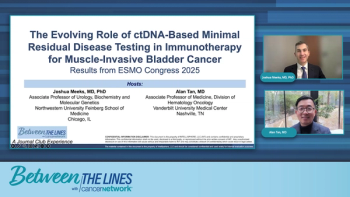
Closing Thoughts, Future Perspectives, and Key Takeaways in the Treatment of Epithelioid Sarcoma
Panelists discuss how early recognition, accurate diagnosis through histopathology and molecular testing, and multidisciplinary collaboration are critical for optimizing treatment strategies in epithelioid sarcoma (ES), while future research into targeted therapies holds promise for improving outcomes, especially in advanced cases.
Episodes in this series

Summary for Physicians: Key Takeaways and Future Perspectives on ES Diagnosis and Treatment
The diagnosis of ES requires a high level of clinical suspicion due to its rarity and varied presentation. Early recognition is crucial, and histopathologic examination combined with molecular testing (eg, INI1 loss) is essential for accurate diagnosis. Multidisciplinary collaboration is key in determining the most appropriate treatment strategy, which often involves a combination of surgery, radiation, and possibly systemic therapies.
Treatment outcomes are influenced by the disease subtype, with the proximal (large cell) form associated with worse prognosis due to its aggressive nature and propensity for metastasis. As ES is highly prone to recurrence and metastasis, close monitoring posttreatment is essential.
Looking ahead, there is a need for better-targeted therapies and clinical trials to improve outcomes, particularly for those with advanced or metastatic disease. Further understanding of the molecular drivers of ES may lead to more personalized treatment options and improved prognosis for patients.
Newsletter
Stay up to date on recent advances in the multidisciplinary approach to cancer.
















































































